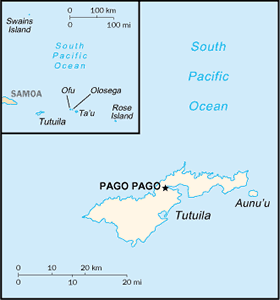The Geography of American Samoa
The Geography of American Samoa
American Samoan Geography
Location: Oceania, group of islands in the South Pacific Ocean, about half way between Hawaii and New Zealand
Geographic coordinates: 14 20 S, 170 00 W
Map references: Oceania
Area: total: 199 sq km land: 199 sq km water: 0 sq km note: includes Rose Island and Swains Island
Area - comparative: slightly larger than Washington, DC
Land boundaries: 0 km
Coastline: 116 km
Maritime claims: territorial sea: 12 nm exclusive economic zone: 200 nm
Climate: tropical marine, moderated by southeast trade winds; annual rainfall averages about 3 m; rainy season (November to April), dry season (May to October); little seasonal temperature variation
Terrain: five volcanic islands with rugged peaks and limited coastal plains, two coral atolls (Rose Island, Swains Island)
Elevation extremes: lowest point: Pacific Ocean 0 m highest point: Lata Mountain 964 m
Natural resources: pumice, pumicite
Land use: arable land: 10% permanent crops: 15% other: 75% (2005)
Irrigated land: NA
Natural hazards: typhoons common from December to March
Environment - current issues: limited natural fresh water resources; the water division of the government has spent substantial funds in the past few years to improve water catchments and pipelines
Environment - international agreements:
Geography - note: Pago Pago has one of the best natural deepwater harbors in the South Pacific Ocean, sheltered by shape from rough seas and protected by peripheral mountains from high winds; strategic location in the South Pacific Ocean


